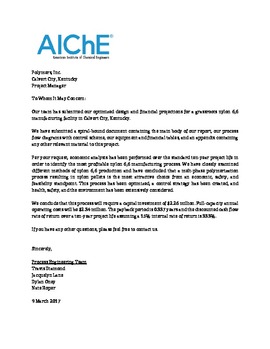| dc.description.abstract | The nylon 6,6 polymerization process contained herein was made in accordance with the problem statement and standards put forth in the 2017 AIChE Student Design Competition. This design was created using Aspen Plus software, which was rigorously compared to an empirical model created in Microsoft Excel to ensure its validity. Various process design elements were considered, but the ultimate design was selected due to its merits from safety, economic, and practicality standpoints. The proposed design for converting aqueous adipic acid (ADA) and hexamethylenediamine (HMDA) utilizes two reaction stages in order to achieve 90% conversion of the feed materials. In order to promote high conversion of feed and keep the nylon in the melt phase, high temperatures and pressures are necessary. Regular maintenance and inspection will help to ensure that no equipment is damaged. These risks and others such as startup and shutdown, chemical hazards, loss of containment, emissions to air, and waste management have been carefully identified and mitigated through a series of active and passive safety measures. Although spun nylon fiber has a higher sale price, it adds considerable complexity to the process and thus is inherently less safe. Instead, the nylon product is shaped into pellets using a pelletizer. This product will be sold for an estimated $1.18/lb based upon nylon market projections. In the future, it would be easy to add the equipment to turn the nylon pellets into fiber if further analysis deems it beneficial. It was requested to design the process so that the process output could be turned down to 67% of its full capacity should demand for nylon 6,6 decrease. The process control scheme aids in this feat; by changing the temperature in the second reaction stage, the process will output the same quality nylon product at a 67% capacity. The capital cost necessary to construct this grassroots process facility in Calvert City, Kentucky is estimated to be $2.26 million. A total of 29 operators will be needed for an annual cost of $1.89 million. If it is assumed that the plan is running at full capacity for a year, the annual utility costs are estimated to be around $450,000. However, the payback period is only 0.337 years as the project annual revenue is $106 million annually. Even if the case was run at 67% of the capacity, the process would still be immensely profitable. Based upon these estimates and assuming a 10-year project life with a 40% tax rate, economic analysis was performed. For the full capacity case, we estimate a net present value of $34 million with a payback period of 4 months. For the turndown case, the net present value is $20 million with a payback period of just over 6 months. Based upon these economic analyses, it has been concluded that this process is very desirable. It is recommended to move into the detailed design stage. | |
